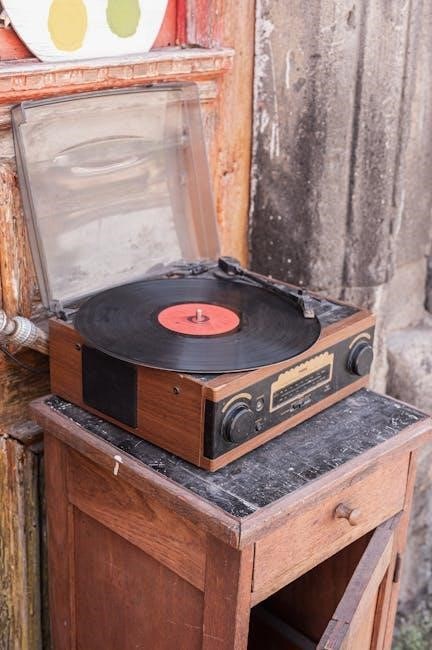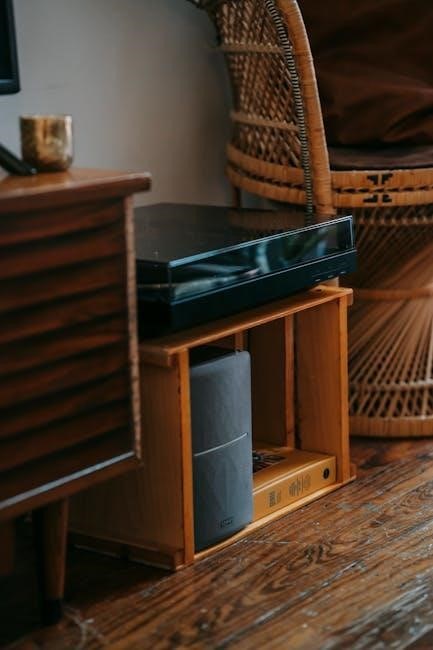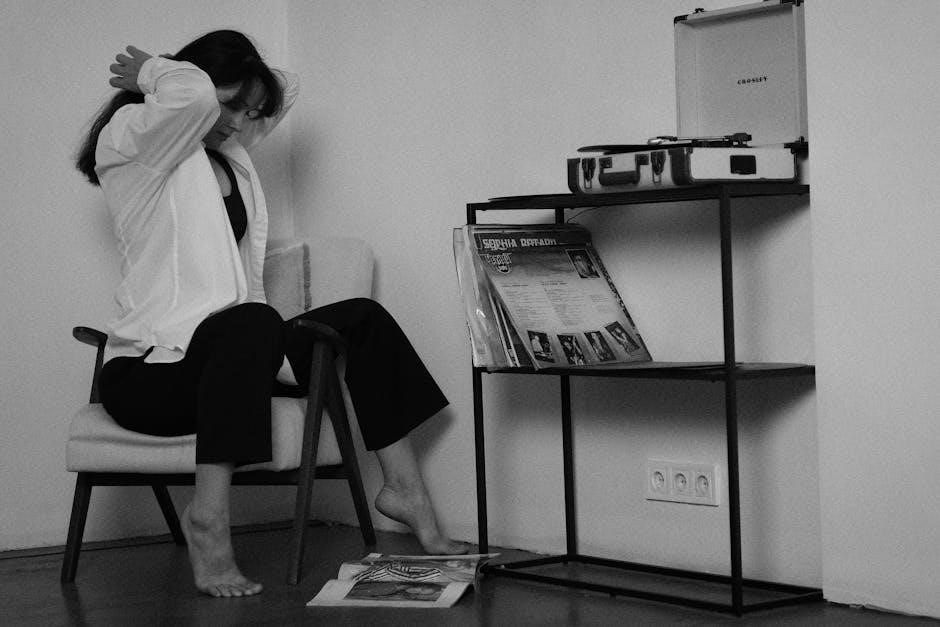crosley record player manual
Summary
Uh oh! Can’t find your Crosley record player manual? Don’t panic! Download it here and get back to spinning those sweet vinyl tunes in no time. Easy peasy!

Crosley Record Player Manual: A Comprehensive Guide
Welcome to your comprehensive guide to understanding your Crosley record player! This manual will navigate you through setup, usage, and maintenance. Whether you’re a first-time user or a seasoned vinyl enthusiast, this guide helps you get the most from your Crosley turntable and provides expert tips and troubleshooting advice.
Understanding Your Crosley Record Player
Crosley record players have become synonymous with accessible vinyl playback, often celebrated for their retro aesthetics and user-friendly designs. These turntables cater to a broad audience, from beginners taking their first steps into the world of vinyl to casual listeners seeking a nostalgic experience. Models like the Crosley Cruiser Deluxe, while sometimes considered more of a “toy” than serious hi-fi equipment, serve a valuable purpose in introducing many to the joys of record collecting.

Understanding the nature of your Crosley player is crucial for ensuring optimal performance and longevity. While some audiophiles may critique their build quality and sonic capabilities, it’s important to appreciate them for what they are: entry-level devices designed for convenience and enjoyment. By acknowledging their limitations and treating them with care, you can avoid potential issues and maximize your listening pleasure.

It’s also important to recognize that different Crosley models boast varying features and capabilities. Some offer Bluetooth connectivity, allowing you to stream music wirelessly, while others prioritize a purely analog experience. Familiarizing yourself with the specific features of your model, as detailed in the user manual, will empower you to make the most of its capabilities.
Initial Setup and Essential Steps
Setting up your Crosley record player correctly from the outset is paramount to ensure proper functionality and prevent potential damage to your vinyl records. The first essential step involves placing the unit on a flat, stable, and level surface. This prevents unwanted vibrations that can negatively impact sound quality. Ensure the location is free from excessive movement or disturbances.
Next, carefully remove any tie-wraps or packaging materials securing the tonearm. The tonearm is a delicate component, and mishandling it can lead to alignment issues or even damage. Once freed, connect the AC adapter to the power jack located on the back of the unit. Do not plug the adapter into the power outlet until all other setup steps are completed.
Carefully place the turntable platter onto the spindle, ensuring it sits securely. If your unit has a 45 RPM adapter, keep it handy for playing smaller records. Now, remove the stylus protector from the stylus assembly to expose the needle. This protective cover is essential for shipping, but must be removed for playback. With these initial steps completed, your Crosley player is almost ready to spin your favorite records.
Connecting to Bluetooth Devices
Many Crosley record players come equipped with Bluetooth connectivity, allowing you to wirelessly stream audio to external speakers or headphones. To initiate the pairing process, first turn the function switch on your Crosley player to the Bluetooth mode. You should hear an activation sound confirming that the Bluetooth function is now enabled and ready to connect.
Next, access the Bluetooth settings on your audio device, whether it’s a smartphone, tablet, or Bluetooth speaker. Initiate a search for available devices. Your Crosley record player should appear in the list of available devices, typically identified as “Crosley CR[model number]”. Select your record player from the list to begin the pairing process.
Upon successful pairing, you will usually hear a short confirmation sound from the Crosley unit, indicating that the connection has been established. Some devices may require you to enter a pairing code; if prompted, try “0000” or consult your device’s manual. Once connected, you can enjoy your vinyl records through your preferred Bluetooth audio output, giving you flexibility in how you listen to your music.

Troubleshooting Common Issues
Experiencing issues with your Crosley record player? Let’s troubleshoot some common problems. If there’s no power, ensure the power adapter is correctly connected to both the record player and a functioning power outlet. Some models have an energy-saving feature that automatically cuts off power after 20 minutes of inactivity. Try turning the power off and then back on to reset it.
If you’re not getting any sound, check the volume knob and ensure it’s turned up. Also, make sure the turntable is set to the correct function (e.g., phono if using the built-in speakers, or Bluetooth if connected to external speakers). If using external speakers, verify that they are properly connected and powered on.
For skipping or distorted sound, clean the stylus with a soft brush, moving from back to front. Ensure the record is clean and free of dust or scratches. If the issue persists, the stylus may need replacement. If the record player is running too fast or slow, check the speed switch and ensure it’s set to the correct RPM for your record (33 1/3 or 45).
Maintenance and Cleaning
Proper maintenance and cleaning are crucial for prolonging the life of your Crosley record player and ensuring optimal sound quality. Regularly clean the stylus to remove dust and debris that can accumulate and cause skipping or distortion. Use a soft brush and gently brush from back to front.
Keep your records clean by using a record cleaning brush and cleaning solution. Wipe the record in a circular motion to remove dust and fingerprints. Store your records in their sleeves and out of direct sunlight to prevent warping.
Periodically clean the turntable surface with a soft, dry cloth to remove dust and dirt. Avoid using harsh chemicals or abrasive cleaners that could damage the finish. Check the belt (if applicable) for wear and tear, and replace it if necessary.
When not in use, cover your Crosley record player with a dust cover to protect it from dust and other particles. By following these simple maintenance tips, you can keep your record player in top condition and enjoy your vinyl collection for years to come.
Understanding the Turntable Components
To fully appreciate and effectively use your Crosley record player, it’s essential to understand its key components. The platter is the rotating disc where you place your vinyl record. The tonearm holds the cartridge and stylus, which reads the grooves of the record. The stylus, also known as the needle, is a very important component and should be handled with care.
The cartridge houses the stylus and converts vibrations into an electrical signal. The counterweight is located at the back of the tonearm and is used to balance the tonearm and adjust the tracking force. The anti-skate control minimizes the inward pull on the tonearm during playback.
The speed selector allows you to switch between different playback speeds (33 1/3 and 45 RPM). The power switch turns the turntable on and off, and the RCA outputs connect the turntable to an external amplifier or speakers. Understanding these components will enhance your listening experience.
Using the Tonearm and Adjusting Tracking Force
The tonearm is a crucial part of your Crosley record player, responsible for accurately tracking the grooves of your vinyl records. Before playing a record, ensure the tonearm is properly balanced. Many Crosley models come with a pre-set tracking force, but understanding how to adjust it is important for optimal performance.
To use the tonearm, gently lift it using the cueing lever (if your model has one) or by hand. Position the tonearm over the desired starting point on the record. Lower the tonearm slowly to begin playback. Avoid dropping the tonearm onto the record, as this can damage both the stylus and the vinyl.
The tracking force is the amount of pressure the stylus applies to the record. Too little tracking force can cause skipping, while too much can wear out your records prematurely. Refer to your Crosley model’s manual for the recommended tracking force and instructions on how to adjust it using the counterweight.
Adjusting Playback Speed and Using the 45 RPM Adapter
Crosley record players are designed to play vinyl records at different speeds: primarily 33 ⅓ RPM (revolutions per minute) for LPs (long-playing albums) and 45 RPM for singles and EPs (extended plays). Adjusting the playback speed correctly is essential for accurate sound reproduction.
Most Crosley models have a speed selector switch, usually located near the tonearm or on the top of the turntable. Simply slide the switch to the appropriate speed setting before playing your record. If the record sounds too slow or too fast, double-check that the speed selector is set correctly.
Some 7-inch records, particularly singles, are designed to be played at 45 RPM. These records have a larger center hole than standard LPs. To play a 45 RPM record on your Crosley turntable, you’ll need to use the included 45 RPM adapter. Place the adapter over the turntable spindle before placing the record on the platter. The adapter fills the gap between the spindle and the record’s center hole, ensuring stable and accurate playback.

Safety Precautions and Guidelines
To ensure safe operation and longevity of your Crosley record player, it’s important to follow basic safety precautions. Always place the turntable on a stable, level surface to prevent it from falling or vibrating excessively, which can damage records and the player itself.
Keep the record player away from water and moisture. Electrical components can malfunction if exposed to liquids, posing a risk of electric shock. Do not operate the player in humid environments or near sinks and bathtubs.
Use only the power adapter that came with your Crosley turntable. Using a different adapter may damage the player or create a fire hazard. Ensure the power outlet is easily accessible so you can quickly disconnect the player in case of an emergency.
Handle the tonearm with care. It’s a delicate component, and mishandling it can damage the stylus or the tonearm assembly. Always use the tonearm lift lever to raise and lower the tonearm gently.
Regularly inspect the power cord for any signs of damage. If the cord is frayed or exposed, discontinue use immediately and replace the cord to prevent electrical hazards.
Exploring Different Crosley Models and Their Features
Crosley offers a diverse range of record players, each with unique features to cater to various preferences and needs. From the portable suitcase-style Cruiser to the more sophisticated C-series, understanding the differences between models is key to choosing the right one for you.
The Cruiser series is known for its portability and built-in speakers, perfect for casual listening and taking your vinyl on the go. These models often feature Bluetooth connectivity, allowing you to stream music from your devices. However, sound quality may be limited compared to higher-end options.
The C-series, such as the C6 and C8, offers enhanced audio performance and a more traditional turntable design. These models typically include adjustable counterweights and anti-skate settings for optimal record playback. They often require external speakers for sound output.
Some Crosley models also offer unique features like CD players, cassette decks, and AM/FM radios, providing an all-in-one entertainment solution. Consider your specific needs and listening habits when exploring the different Crosley models to find the perfect fit.
Additionally, explore models with USB recording capabilities, allowing you to convert your vinyl records into digital formats for convenient storage and playback on various devices.
Finding the Right Manual for Your Specific Model
Locating the correct manual for your Crosley record player is crucial for proper setup, operation, and troubleshooting. Crosley produces a wide array of models, each with its own specific features and instructions. Using the wrong manual can lead to confusion or even damage to your turntable.
The first step is to identify your exact Crosley model number. This is usually found on a sticker located on the bottom or back of the unit. Once you have the model number, you can begin your search for the corresponding manual.
Crosley’s official website is a great place to start. Look for a “Support” or “Manuals” section, where you can typically enter your model number to download the correct PDF manual. If you can’t find it on the official site, try searching online using the model number and the term “user manual” or “instruction manual.”
Websites like ManualsLib are great resources for manuals. You can often find the manual by searching with a specific model.
If you purchased your Crosley record player new, the manual may have been included in the packaging. Check any boxes or paperwork you may have kept. If you purchased it used, contact Crosley customer service, who may be able to provide you with a digital copy of the manual.